|
america's dynamic workforce: 2006 |
The 21st century
labor market seeks and rewards workers who can offer the educational
foundation, technical skills and creative flexibility that employers
need to compete and to adapt to changing needs successfully. Higher
educational attainment contributes to a worker’s ability to efficiently
absorb new knowledge and to learn new skills. Workers who can quickly
move up the learning curve of a new job have a competitive advantage for
economic success
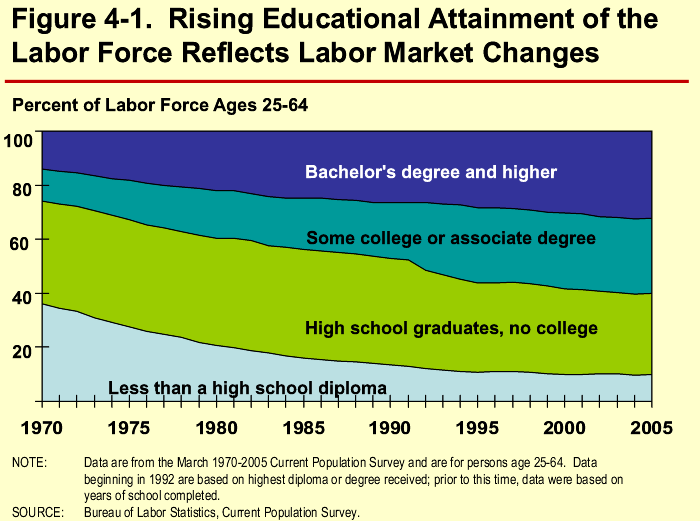
-
Sixty-five years ago only about one in twenty Americans ages 25 or older
was a college graduate. Many jobs required no more than basic literacy
and physical skills largely learned through experience. The change in
the educational attainment of the labor force since the 1940s has been
dramatic. Still, as recently as 1970, a high school diploma was
sufficient for most jobs, and 38.1 percent of the labor force (23.5
million persons) had completed no education beyond high school (12th
grade).[15]
- The
proportion of persons ages 25 to 64 years old with some college (or an
associate degree) more than doubled between 1970 and 2005. The share with a
bachelor’s degree or higher also more than doubled over the period. In
contrast, the share of the labor force with less than a high school diploma
declined markedly.
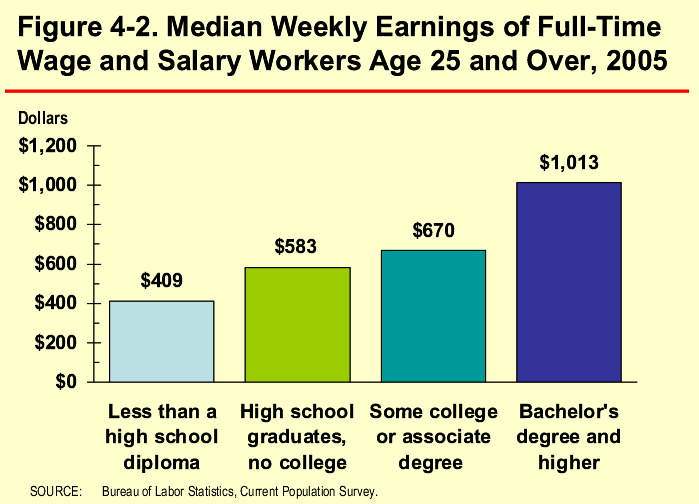
-
Among workers 25 years old and over, median weekly earnings of wage and
salary workers who usually work full time are nearly two and a half
times more for persons with at least a college degree than for those who
have not completed high school. The weekly difference of $604 in 2005
would amount to an annual difference of $31,408 if extended over a
52-week year.
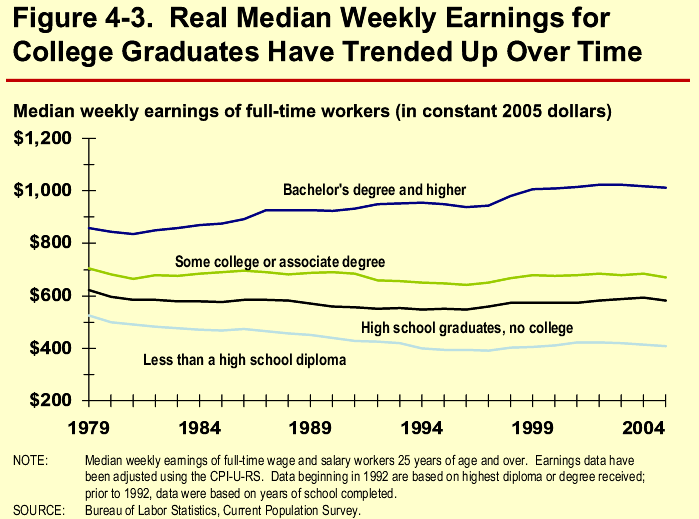
- In
1979, the $334 difference (in 2005 inflation-adjusted dollars) in median
weekly earnings of usual full-time workers between those with less than
a high school diploma and those who had completed 4 or more years of
college amounted to a 63.7 percent education premium – college
completers enjoyed 1.6 times higher median weekly earnings than high
school dropouts.
- By
2005, the education premium had risen to 148 percent: College graduates
with a bachelor’s or higher degree had median weekly earnings nearly 2.5
times greater than the typical high school dropout earned.
- Only
college graduates have experienced growth in real median weekly earnings
since 1979. In contrast, high school dropouts have seen their real median
weekly earnings decline by about 20 percent.[16]
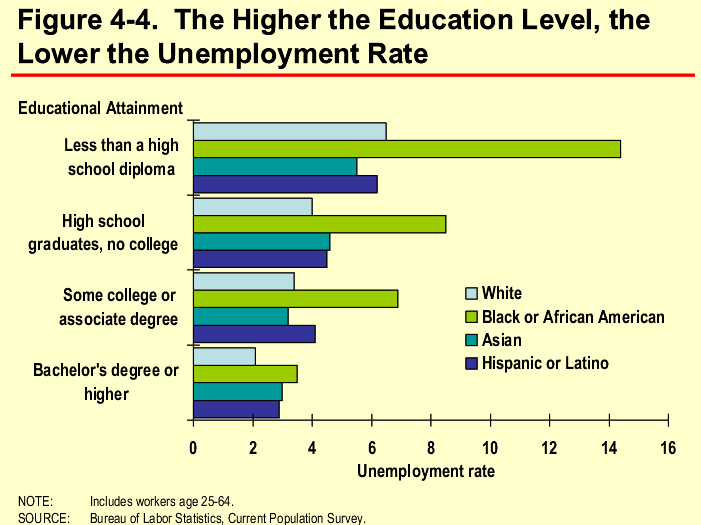
- In
2005, the unemployment rate for college graduates (bachelor’s degree or
higher) age 25 and older averaged 2.3 percent. In comparison, persons
age 25 or older without a high school diploma experienced 7.6 percent
unemployment on average. The corresponding unemployment rate for high
school graduates with no college was 4.7 percent, and the unemployment
rate for those with some college but less than a bachelor’s degree was
3.9 percent.
-
Higher educational attainment is associated with lower unemployment
rates regardless of race or ethnicity. The unemployment rate, however,
is particularly lower for African American college graduates than high
school dropouts. – 3.5 percent for college graduates versus 14.4 percent
for those without a high school diploma (or GED).

-
The relative cost of being a high school dropout has grown in terms of
unemployment risk. The unemployment rate for high school dropouts
spiked in the early 1980s, and while trending downward somewhat since
then, it is still considerably higher than for other groups. The
jobless rate for college graduates has been consistently lower and less
subject to business cycle fluctuations than the unemployment rates
associated with lower educational attainment.
-
The gap in unemployment rates between those with a 4-year college degree
and those without a high school diploma has increased since 1970.
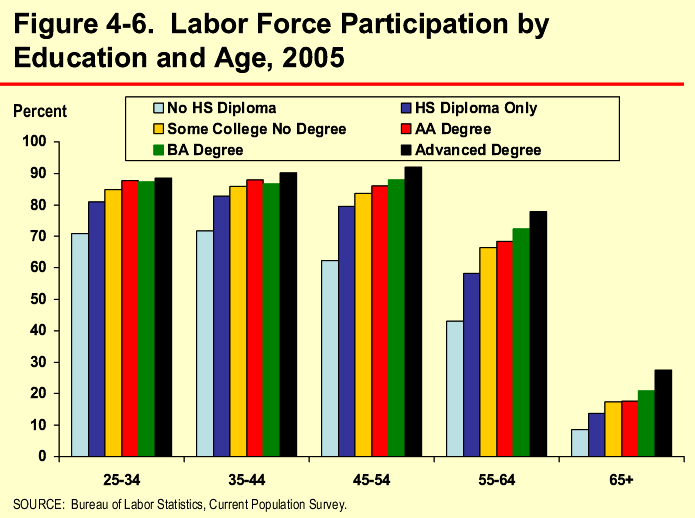
-
Despite the overall differences in educational attainment across the age
groups, higher educational attainment is associated with higher labor
force participation within each age cohort.
-
For the oldest Americans (ages 65 and older) 27.4 percent of the 2.7
million with advanced degrees and 20.9 percent of those with bachelor’s
degrees only were in the labor force in 2005.[17]
- Among the 65 and older age group, only 8.7 percent of persons without a high
school diploma and 13.8 percent of persons with a high school diploma but no
college were in the labor market.
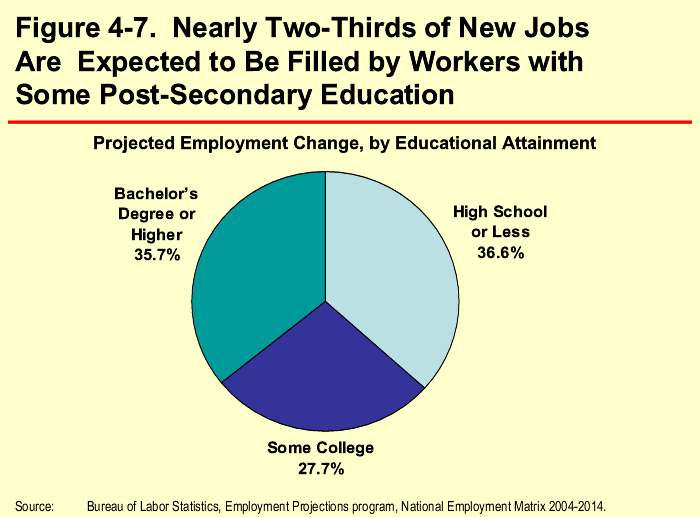
-
Projections for 2004 through 2014 indicate that nearly two-thirds (63.4
percent) of the projected 18.9 million new jobs will most likely be
filled by workers with some post-secondary education.
-
While most of the 18.9 million new job openings because of growth will
be in occupations for which workers with higher educational attainment
will be the most suited, there will also be many jobs available for
those with less education.
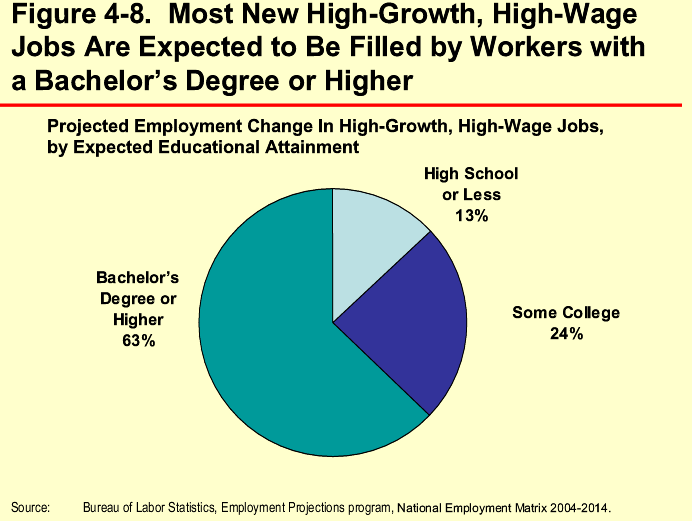
-
Within the projected job growth category, the projection for the
high-growth, high-wage subgroup is particularly noteworthy.
- Of
the 18.9 million new jobs associated with projected growth by 2014, 8.7
million fall within the high-growth, high-wage group. Among those
occupations with both high growth and high wages, 87.0 percent of new
jobs are expected to be filled by workers with at least some
post-secondary education.
- Within
the high-growth, high-wage group, 5.5 million jobs (62.8 percent of the
total) will most likely be filled by workers with at least a bachelor’s
degree and 2.1 million (24.2 percent) by those with some post-secondary
education, such as a two-year community college academic program, a
vocational certificate or specialized formal training.
|











